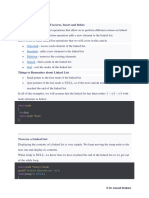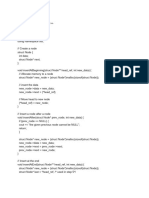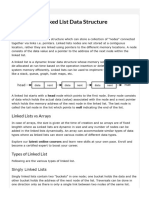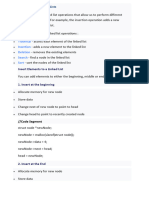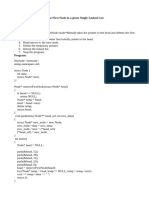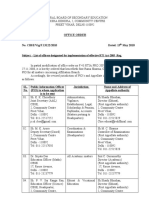C++ Linked List Operations
C++ Linked List Operations
Uploaded by
Ishaan kataraCopyright:
Available Formats
C++ Linked List Operations
C++ Linked List Operations
Uploaded by
Ishaan kataraOriginal Title
Copyright
Available Formats
Share this document
Did you find this document useful?
Is this content inappropriate?
Copyright:
Available Formats
C++ Linked List Operations
C++ Linked List Operations
Uploaded by
Ishaan kataraCopyright:
Available Formats
Linked List Operations: Traverse,
Insert and Delete
In this tutorial, you will learn different operations on a linked list. Also, you
will find implementation of linked list operations in C++.
There are various linked list operations that allow us to perform different
actions on linked lists. For example, the insertion operation adds a new
element to the linked list.
Here's a list of basic linked list operations that we will cover in this article.
• Traversal - access each element of the linked list
• Insertion - adds a new element to the linked list
• Deletion - removes the existing elements
• Search - find a node in the linked list
• Sort - sort the nodes of the linked list
Before you learn about linked list operations in detail, make sure to know
about Linked List first.
Things to Remember about Linked List
• head points to the first node of the linked list
• next pointer of the last node is NULL , so if the next current node is NULL ,
we have reached the end of the linked list.
In all of the examples, we will assume that the linked list has three nodes 1
--->2 --->3 with node structure as below:
struct node {
int data;
struct node *next;
};
Website: www.vcaretechnicalinstitute.com For Batches Call Now: +91-8319004365
Traverse a Linked List
Displaying the contents of a linked list is very simple. We keep moving the
temp node to the next one and display its contents.
When temp is NULL , we know that we have reached the end of the linked list
so we get out of the while loop.
struct node *temp = head;
printf("\n\nList elements are - \n");
while(temp != NULL) {
printf("%d --->",temp->data);
temp = temp->next;
}
The output of this program will be:
List elements are -
1 --->2 --->3 --->
Insert Elements to a Linked List
You can add elements to either the beginning, middle or end of the linked
list.
1. Insert at the beginning
• Allocate memory for new node
• Store data
Website: www.vcaretechnicalinstitute.com For Batches Call Now: +91-8319004365
• Change next of new node to point to head
• Change head to point to recently created node
struct node *newNode;
newNode = malloc(sizeof(struct node));
newNode->data = 4;
newNode->next = head;
head = newNode;
2. Insert at the End
• Allocate memory for new node
• Store data
• Traverse to last node
• Change next of last node to recently created node
struct node *newNode;
newNode = malloc(sizeof(struct node));
newNode->data = 4;
newNode->next = NULL;
struct node *temp = head;
while(temp->next != NULL){
temp = temp->next;
}
temp->next = newNode;
3. Insert at the Middle
• Allocate memory and store data for new node
• Traverse to node just before the required position of new node
• Change next pointers to include new node in between
Website: www.vcaretechnicalinstitute.com For Batches Call Now: +91-8319004365
struct node *newNode;
newNode = malloc(sizeof(struct node));
newNode->data = 4;
struct node *temp = head;
for(int i=2; i < position; i++) {
if(temp->next != NULL) {
temp = temp->next;
}
}
newNode->next = temp->next;
temp->next = newNode;
Delete from a Linked List
You can delete either from the beginning, end or from a particular position.
1. Delete from beginning
• Point head to the second node
head = head->next;
2. Delete from end
• Traverse to second last element
• Change its next pointer to null
struct node* temp = head;
while(temp->next->next!=NULL){
temp = temp->next;
}
temp->next = NULL;
Website: www.vcaretechnicalinstitute.com For Batches Call Now: +91-8319004365
3. Delete from middle
• Traverse to element before the element to be deleted
• Change next pointers to exclude the node from the chain
for(int i=2; i< position; i++) {
if(temp->next!=NULL) {
temp = temp->next;
}
}
temp->next = temp->next->next;
Search an Element on a Linked List
You can search an element on a linked list using a loop using the following
steps. We are finding item on a linked list.
• Make head as the current node.
• Run a loop until the current node is NULL because the last element
points to NULL .
• In each iteration, check if the key of the node is equal to item . If it the
key matches the item, return true otherwise return false .
// Search a node
bool searchNode(struct Node** head_ref, int key) {
struct Node* current = *head_ref;
while (current != NULL) {
if (current->data == key) return true;
current = current->next;
}
return false;
Website: www.vcaretechnicalinstitute.com For Batches Call Now: +91-8319004365
}
Sort Elements of a Linked List
We will use a simple sorting algorithm, Bubble Sort, to sort the elements of
a linked list in ascending order below.
1. Make the head as the current node and create another node index for
later use.
2. If head is null, return.
3. Else, run a loop till the last node (i.e. NULL ).
4. In each iteration, follow the following step 5-6.
5. Store the next node of current in index .
6. Check if the data of the current node is greater than the next node. If
it is greater, swap current and index .
Check the article on bubble sort for better understanding of its working.
// Sort the linked list
void sortLinkedList(struct Node** head_ref) {
struct Node *current = *head_ref, *index = NULL;
int temp;
if (head_ref == NULL) {
return;
} else {
while (current != NULL) {
// index points to the node next to current
index = current->next;
while (index != NULL) {
if (current->data > index->data) {
temp = current->data;
current->data = index->data;
index->data = temp;
Website: www.vcaretechnicalinstitute.com For Batches Call Now: +91-8319004365
}
index = index->next;
}
current = current->next;
}
}
}
LinkedList Operations in C++
// Linked list operations in C++
#include <stdlib.h>
#include <iostream>
using namespace std;
// Create a node
struct Node {
int data;
struct Node* next;
};
void insertAtBeginning(struct Node** head_ref, int new_data) {
// Allocate memory to a node
struct Node* new_node = (struct Node*)malloc(sizeof(struct Node));
// insert the data
new_node->data = new_data;
new_node->next = (*head_ref);
// Move head to new node
(*head_ref) = new_node;
}
// Insert a node after a node
void insertAfter(struct Node* prev_node, int new_data) {
if (prev_node == NULL) {
cout << "the given previous node cannot be NULL";
Website: www.vcaretechnicalinstitute.com For Batches Call Now: +91-8319004365
return;
}
struct Node* new_node = (struct Node*)malloc(sizeof(struct Node));
new_node->data = new_data;
new_node->next = prev_node->next;
prev_node->next = new_node;
}
// Insert at the end
void insertAtEnd(struct Node** head_ref, int new_data) {
struct Node* new_node = (struct Node*)malloc(sizeof(struct Node));
struct Node* last = *head_ref; /* used in step 5*/
new_node->data = new_data;
new_node->next = NULL;
if (*head_ref == NULL) {
*head_ref = new_node;
return;
}
while (last->next != NULL) last = last->next;
last->next = new_node;
return;
}
// Delete a node
void deleteNode(struct Node** head_ref, int key) {
struct Node *temp = *head_ref, *prev;
if (temp != NULL && temp->data == key) {
*head_ref = temp->next;
free(temp);
return;
}
// Find the key to be deleted
while (temp != NULL && temp->data != key) {
prev = temp;
temp = temp->next;
}
// If the key is not present
Website: www.vcaretechnicalinstitute.com For Batches Call Now: +91-8319004365
if (temp == NULL) return;
// Remove the node
prev->next = temp->next;
free(temp);
}
// Search a node
bool searchNode(struct Node** head_ref, int key) {
struct Node* current = *head_ref;
while (current != NULL) {
if (current->data == key) return true;
current = current->next;
}
return false;
}
// Sort the linked list
void sortLinkedList(struct Node** head_ref) {
struct Node *current = *head_ref, *index = NULL;
int temp;
if (head_ref == NULL) {
return;
} else {
while (current != NULL) {
// index points to the node next to current
index = current->next;
while (index != NULL) {
if (current->data > index->data) {
temp = current->data;
current->data = index->data;
index->data = temp;
}
index = index->next;
}
current = current->next;
}
}
}
Website: www.vcaretechnicalinstitute.com For Batches Call Now: +91-8319004365
// Print the linked list
void printList(struct Node* node) {
while (node != NULL) {
cout << node->data << " ";
node = node->next;
}
}
// Driver program
int main() {
struct Node* head = NULL;
insertAtEnd(&head, 1);
insertAtBeginning(&head, 2);
insertAtBeginning(&head, 3);
insertAtEnd(&head, 4);
insertAfter(head->next, 5);
cout << "Linked list: ";
printList(head);
cout << "\nAfter deleting an element: ";
deleteNode(&head, 3);
printList(head);
int item_to_find = 3;
if (searchNode(&head, item_to_find)) {
cout << endl << item_to_find << " is found";
} else {
cout << endl << item_to_find << " is not found";
}
sortLinkedList(&head);
cout << "\nSorted List: ";
printList(head);
}
Website: www.vcaretechnicalinstitute.com For Batches Call Now: +91-8319004365
You might also like
- Module 1 Lesson 2 Basic Concepts For Construction DatabaseDocument23 pagesModule 1 Lesson 2 Basic Concepts For Construction DatabaseErza LeeNo ratings yet
- Rhel 5 6 7 8 Cheatsheet 8.5x11 0519 0Document5 pagesRhel 5 6 7 8 Cheatsheet 8.5x11 0519 0hoadiNo ratings yet
- Handbook of Thermodynamic Diagrams Volume 3 PDFDocument407 pagesHandbook of Thermodynamic Diagrams Volume 3 PDFcyclon2010No ratings yet
- Linked List OperationsDocument5 pagesLinked List OperationsKBS SrikarNo ratings yet
- Linked List Operations in C-Document4 pagesLinked List Operations in C-Toshu SharmaNo ratings yet
- Lecture 3Document22 pagesLecture 3Md.Nazmul Abdal ShourovNo ratings yet
- Single Lin ListDocument35 pagesSingle Lin ListSumant ReddyNo ratings yet
- 15.1 C++ Circular Linked ListDocument13 pages15.1 C++ Circular Linked ListIshaan kataraNo ratings yet
- Cembrano, Stephanie Rei Allana S. DICT 2-1 Quiz 1Document4 pagesCembrano, Stephanie Rei Allana S. DICT 2-1 Quiz 1Rei CembranoNo ratings yet
- Linkedlist SolutionsDocument18 pagesLinkedlist SolutionsParminder SinghNo ratings yet
- EC-233 Data Structures and Algorithms: Lab Report#05Document11 pagesEC-233 Data Structures and Algorithms: Lab Report#05Mahnoor InamNo ratings yet
- Linked List Data StructureDocument27 pagesLinked List Data StructureashfaquexkhanNo ratings yet
- Linked List A5Document196 pagesLinked List A5蔡炅宸100% (1)
- Linked ListDocument258 pagesLinked ListBhavneet SinghNo ratings yet
- Traversal Insertion Deletion Search Sort: Operations On Linked ListsDocument4 pagesTraversal Insertion Deletion Search Sort: Operations On Linked ListsAnacademy FreeNo ratings yet
- C++ Program To Delete The First Node in A Given Singly Linked List AlgorithmDocument14 pagesC++ Program To Delete The First Node in A Given Singly Linked List AlgorithmIT sacwcNo ratings yet
- QB Ref1 UpdatedDocument40 pagesQB Ref1 UpdatedBangtan TwttNo ratings yet
- Lab3 - Linked List - SolutionDocument10 pagesLab3 - Linked List - Solutiondemro channelNo ratings yet
- 15.2 C++ Doubly Linked ListDocument19 pages15.2 C++ Doubly Linked ListIshaan kataraNo ratings yet
- DSA Exp 6, Mhase Sanchit Kishor, Roll No. 29, Div EDocument5 pagesDSA Exp 6, Mhase Sanchit Kishor, Roll No. 29, Div ESwaraj KhedekarNo ratings yet
- Singly Linked ListDocument29 pagesSingly Linked ListMaham uroojNo ratings yet
- Automata Problem Solution UpdatedDocument19 pagesAutomata Problem Solution UpdatedAmrita Pandey100% (1)
- 15IT305 Data Structures and AlgorithmsDocument128 pages15IT305 Data Structures and AlgorithmsHarish ramNo ratings yet
- Exchange First and Last Nodes in Circular Linked List: Filter - None Edit Play - Arrow Brightness - 4Document19 pagesExchange First and Last Nodes in Circular Linked List: Filter - None Edit Play - Arrow Brightness - 4Hari VenkateshNo ratings yet
- Muhammad Ahmad Bilal (1032) Double LinklistDocument12 pagesMuhammad Ahmad Bilal (1032) Double LinklistMalik JameelNo ratings yet
- M.Tech JNTUK ADS UNIT-1Document20 pagesM.Tech JNTUK ADS UNIT-1Manthena Narasimha RajuNo ratings yet
- Portfolio Chapter 5Document5 pagesPortfolio Chapter 5duttapratim515No ratings yet
- DSNotes Using JavaDocument103 pagesDSNotes Using JavaPRANAV CHAUDHARINo ratings yet
- notes_CPDocument46 pagesnotes_CPHarsh GoelNo ratings yet
- 1) Detect Loop in A Linked List: Floyd's Cycle-Finding AlgorithmDocument80 pages1) Detect Loop in A Linked List: Floyd's Cycle-Finding AlgorithmHari VenkateshNo ratings yet
- Single Linked ListsDocument11 pagesSingle Linked ListsayazhussainNo ratings yet
- exp3_SLL_2023800036Document5 pagesexp3_SLL_2023800036rayansjain29No ratings yet
- Del Data Structure With C++ Part3Document10 pagesDel Data Structure With C++ Part3pragatiraichanNo ratings yet
- Rajat Kumar Singh - DS Lab-01Document7 pagesRajat Kumar Singh - DS Lab-01tanishq.verma2020No ratings yet
- Single Linked ListDocument30 pagesSingle Linked Listreetinder kundhalNo ratings yet
- Unit IiDocument6 pagesUnit IiMary Nisha D Assistant ProfessorNo ratings yet
- Experiments of Data StructureDocument14 pagesExperiments of Data StructureNikitaNo ratings yet
- Lab 4 DsaDocument9 pagesLab 4 DsaWarda tu ZahraNo ratings yet
- Lecture 1&2 PDFDocument44 pagesLecture 1&2 PDFomar essamNo ratings yet
- Week 5Document15 pagesWeek 5jovialgoodall4No ratings yet
- P4 LinkedListDocument3 pagesP4 LinkedListkunal.bhoi.stNo ratings yet
- It221 Midterm Exam ReviewerDocument8 pagesIt221 Midterm Exam ReviewerRodver Angelo EsperaNo ratings yet
- Major AssignDocument26 pagesMajor Assign3wpaoNo ratings yet
- C LinkedListDocument10 pagesC LinkedListBhaskar NaiduNo ratings yet
- Project DsDocument20 pagesProject Dsashtar kazmiNo ratings yet
- Linked ListDocument99 pagesLinked ListLovekush KumarNo ratings yet
- DS HA-2 SolutionsDocument9 pagesDS HA-2 SolutionsV SUBRAHMANYAMNo ratings yet
- Swap KTH Node From Beginning With KTH Node From End in A Linked ListDocument63 pagesSwap KTH Node From Beginning With KTH Node From End in A Linked ListHari VenkateshNo ratings yet
- Lab 03Document8 pagesLab 03Shakeel AhmadNo ratings yet
- Daaa 4Document12 pagesDaaa 4The Trading FreakNo ratings yet
- Data Structures (C++) : - This PPT Is Dedicated To My Inner Controller AMMADocument118 pagesData Structures (C++) : - This PPT Is Dedicated To My Inner Controller AMMARaghunath2uNo ratings yet
- Lab01 LinkedListDocument9 pagesLab01 LinkedListfuncosy13No ratings yet
- Linked Lists AlgorithmDocument5 pagesLinked Lists Algorithmadenoch113No ratings yet
- Experiment No. 1Document45 pagesExperiment No. 1KARAN RATHODNo ratings yet
- CS210 DSA Lab 05Document9 pagesCS210 DSA Lab 05Shehzad AhmadNo ratings yet
- Doubly Linked ListDocument5 pagesDoubly Linked Listkunalm3456No ratings yet
- Lab Task by Sahil 031Document7 pagesLab Task by Sahil 031abdullahNo ratings yet
- Circular and Double Linked List ExplanationDocument7 pagesCircular and Double Linked List ExplanationMadhusha sewwandiNo ratings yet
- Lab Report 5 DsDocument9 pagesLab Report 5 DscmtajuddinchowdhuryNo ratings yet
- grounded header LLDocument5 pagesgrounded header LLAyush SharmaNo ratings yet
- Dsa Week 2 UpdatesDocument73 pagesDsa Week 2 Updatesriyabhart02No ratings yet
- C Programming and Data Structures (R20 Syllabus JNTUA, Anantapuramu)Document8 pagesC Programming and Data Structures (R20 Syllabus JNTUA, Anantapuramu)krupa522No ratings yet
- ADVANCED DATA STRUCTURES FOR ALGORITHMS: Mastering Complex Data Structures for Algorithmic Problem-Solving (2024)From EverandADVANCED DATA STRUCTURES FOR ALGORITHMS: Mastering Complex Data Structures for Algorithmic Problem-Solving (2024)No ratings yet
- The Khyber Pakhtunkhwa Wildlife and Biodiversity Protection Preservation Conservation and Management Act 2015Document43 pagesThe Khyber Pakhtunkhwa Wildlife and Biodiversity Protection Preservation Conservation and Management Act 2015Hashim ShahzadNo ratings yet
- Marketing Analytics: PPT-1 (Introduction & Financial Perspective Metrics)Document26 pagesMarketing Analytics: PPT-1 (Introduction & Financial Perspective Metrics)Madeeha KhanNo ratings yet
- Print Edition: 23 May 2014Document21 pagesPrint Edition: 23 May 2014Dhaka TribuneNo ratings yet
- Installation Guide For Moldex3DDocument70 pagesInstallation Guide For Moldex3DduongthanhminhhieuNo ratings yet
- Do You Get Stressed When Travelling?: VocabularyDocument13 pagesDo You Get Stressed When Travelling?: VocabularyMaria Pinzon100% (1)
- Nursing Care PlanDocument3 pagesNursing Care PlanCspc Crcyc50% (2)
- Wajo 18 QnsolnDocument16 pagesWajo 18 QnsolnSmpnsatubontang KaltimNo ratings yet
- List of Officers Designated in RTI 2010Document4 pagesList of Officers Designated in RTI 2010Aishwarya SahneyNo ratings yet
- CourageDocument5 pagesCourageketian15No ratings yet
- Pe Tutorial 2 PDFDocument10 pagesPe Tutorial 2 PDFkibrom atsbhaNo ratings yet
- BC 10Document50 pagesBC 10Jorge rodriNo ratings yet
- Romania National Olympiad 2005-25-142Document6 pagesRomania National Olympiad 2005-25-142nicolas100% (1)
- Reflection Paper About Ang GuroDocument5 pagesReflection Paper About Ang Guroarnulfo duarte50% (4)
- CatalogDocument28 pagesCatalogMedy Agung PermanaNo ratings yet
- 2022-12-31Document365 pages2022-12-31Durjoy DasNo ratings yet
- Duck, Cover, and Hold During The FirstDocument3 pagesDuck, Cover, and Hold During The FirstSaluibTanMelNo ratings yet
- Positive Discipline Vs PunishmentDocument5 pagesPositive Discipline Vs PunishmentGatoy GadotNo ratings yet
- ARIMA PaperDocument3 pagesARIMA PaperroziahzailanNo ratings yet
- Group 1&2 Revised Burn CsDocument55 pagesGroup 1&2 Revised Burn CsStephany Dela CruzNo ratings yet
- Csslessonplan 1Document9 pagesCsslessonplan 1Aijunful TabayNo ratings yet
- An Efficient Frontier For Retirement IncomeDocument12 pagesAn Efficient Frontier For Retirement IncomeJulian Restrepo0% (1)
- 1236 ArticleText 2402 1 10 20210401 PDFDocument6 pages1236 ArticleText 2402 1 10 20210401 PDFWarda SariNo ratings yet
- Paper 1 Mock ExamDocument7 pagesPaper 1 Mock ExammaureenNo ratings yet
- NMDC Recruitment 2019 For EngineersDocument8 pagesNMDC Recruitment 2019 For EngineersfruitnutsNo ratings yet
- 3 VariablesDocument34 pages3 VariablesRon TrimillosNo ratings yet
- Reflection #1 - The Prodigal SonDocument1 pageReflection #1 - The Prodigal SonaltcrythingyNo ratings yet
- ءاوهلا فييكت تاموُظنم Air-Conditioning Systems - Mee51413 سماخلا فصلاDocument31 pagesءاوهلا فييكت تاموُظنم Air-Conditioning Systems - Mee51413 سماخلا فصلاali awadNo ratings yet



